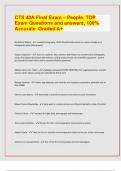Exam (elaborations)
MATERNITY HESI 1 TEST BANK 2020
- Course
- Institution
MATERNITY HESI 1 TEST BANK 2020 A 38-week primigravida who works as a secretary and sits at a computer for 8 hours each day tells the nurse that her feet have begun to swell. Which instruction would be most effective in preventing pooling of blood in the lower extremities? Ans: Move about every...
[Show more]












